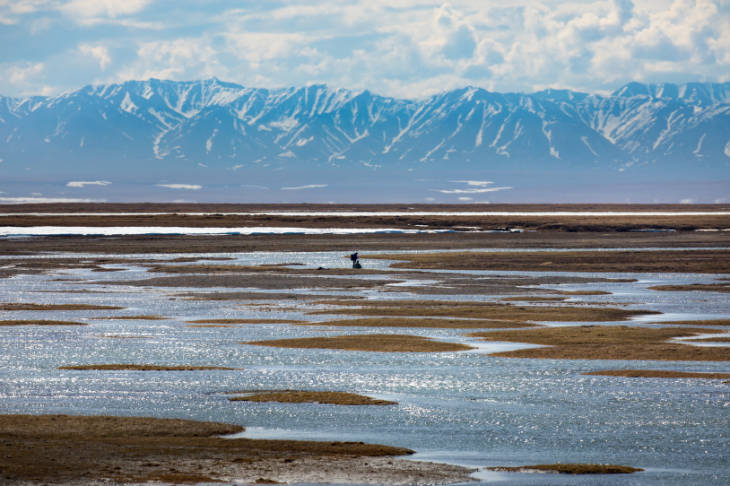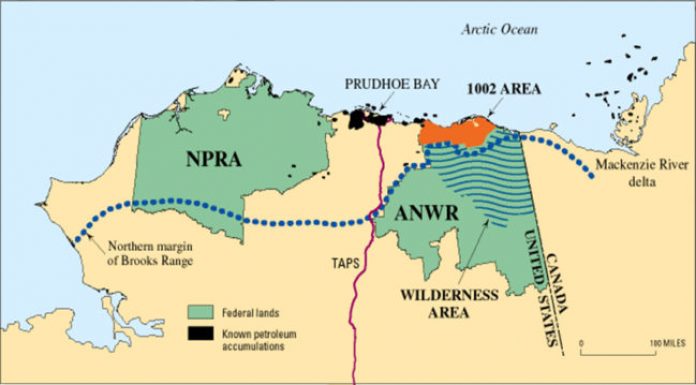Trump Administration Rushes To Sell Arctic National Wildlife Refuge Land For Drilling
12:12 minutes
 This segment is part of The State of Science, a series featuring science stories from public radio stations across the United States. This story by Tegan Hanlon originally appeared on Alaska Public Media.
This segment is part of The State of Science, a series featuring science stories from public radio stations across the United States. This story by Tegan Hanlon originally appeared on Alaska Public Media.
In a last-minute push, the Trump administration announced Thursday that it plans to auction off drilling rights in the Arctic National Wildlife Refuge in just over a month, setting up a final showdown with opponents before President-elect Joe Biden takes office.
The sale, which is set for Jan. 6, could cap a bitter, decades-long battle over whether to drill in the refuge’s coastal plain, and it would seal the administration’s efforts to open the land to development.
“We’ve followed a very logical and fairly lengthy, certainly very involved and public-oriented process to get us to this point. And this is the next logical step,” said Kevin Pendergast, deputy state director for resources with the Bureau of Land Management in Alaska.
But conservation and tribal groups who oppose oil and gas development in the coastal plain strongly disagree. And they blasted the administration on Thursday, saying it’s cutting corners so it can hand over leases to oil companies before Biden, who opposes drilling in the refuge, is sworn in and can block it.
“You’re one mile from the finish line and you decide to take a shortcut is what this screams to me, and you hope you don’t get caught,” said Matt Newman, a senior staff attorney at the Native American Rights Fund in Anchorage. He represents three Gwich’in tribes who live near the refuge and oppose drilling on the coastal plain.
“This just smacks in the face of a normal procedure,” he said.

BLM’s announcement of a sale date Thursday came just about two weeks into its “call for nominations,” a 30-day window when oil companies and others can tell the government, confidentially, which tracts of land they’re interested in bidding on.
Typically, once that period ends, the government analyzes the comments to inform which pieces of land it will offer in a lease sale—and then the date of a sale is announced, said Athan Manuel, a lobbyist for the Sierra Club, which is opposed to drilling.
“The oil and gas program is usually more scheduled and systematic and by the book,” Manuel said. “That’s not happening with this case.”
Pendergast countered that the government is following regulations, including providing a 30-day notice of a lease sale.
“This just smacks in the face of a normal procedure.”
A statement about the sale will be posted online Monday, detailing which areas the government will offer for leasing. The call for nominations ends 10 days later, on Dec. 17.
“We’re allowing for the various steps of the process to take place,” Pendergast said. “We can put those together in different ways at different times.”
Matt Lee-Ashley, a former deputy interior secretary under President Barack Obama, described the Trump administration as “hell-bent on selling off the Arctic Refuge on its way out the door, rules and laws be damned.”
“This whole boondoggle can and should be tossed in the trash by the courts or the next administration,” Lee-Ashley, who’s now a senior fellow at the Center for American Progress, a left-leaning think tank, said in a prepared statement.
Already, conservation and tribal groups, as well as a coalition of 15 states, have filed lawsuits challenging the Trump administration’s environmental reviews. Opponents have also secured pledges from an array of banks that say they won’t finance oil development in the refuge.
The coastal plain represents about 8% of the vast refuge. And while it’s home to polar bears, caribou and other wildlife, it’s also thought to hold billions of barrels of oil.
“Today we put the oil industry on notice,” said a statement Thursday from Jamie Rappaport Clark, head of Defenders of Wildlife. “Any oil companies that bid on lease sales for the coastal plain of Arctic National Wildlife Refuge should brace themselves for an uphill legal battle fraught with high costs and reputational risks.”
The coastal plain, also known as the 1002 Area, covers about 1.6 million acres. It’s roughly the size of Delaware.
It represents about 8% of the vast refuge. And while it’s home to polar bears, caribou and other wildlife, it’s also thought to hold billions of barrels of oil.

In a dramatic shift after nearly four decades of protections, a Republican-led Congress approved legislation in 2017 that opened up the coastal plain to oil development. It required two lease sales within seven years, the first scheduled for no later than the end of 2021.
In Kaktovik, the only community inside the coastal plain, some residents greeted Thursday’s news with enthusiasm. Matthew Rexford, Kaktovik’s tribal administrator, said drilling could boost the local economy.
“We have watched oil and gas development on the North Slope for almost 50 years,” he said in a phone interview. “And we believe that through the stringent regulatory environment and the oversight of our home rule borough, the North Slope Borough, all impacts from exploration and development can be mitigated to preserve the area.”
Alaska’s Congressional delegation, which has pushed to open the coastal plain to drilling, also praised Thursday’s announcement, saying development will create jobs. Kara Moriarty, head of the Alaska Oil and Gas Association, said it’s also good for the industry.
“Having a lease sale is the first step of getting access to responsibly developing resources that are needed to meet global demand,” Moriarty said.
Moriarty said she would not call the administration’s process rushed, since drilling in the refuge has been debated for decades. But she did say oil companies will have less time to prepare their bids than they normally do.
It remains unclear who might participate in a coastal plain lease sale. Oil and gas companies aren’t talking publicly about whether they plan to bid.
BLM says the sale will be conducted by video livestream.
Alaska Public Media’s Nat Herz contributed to this story. You can find more reporting on Alaska Public Media.
Invest in quality science journalism by making a donation to Science Friday.
Tegan Hanlon is the Alaska energy desk reporter at Alaska Public Media and is based in Anchorage, Alaska.
Sarah James is a Neetsa’ii Gwich’in elder and an anti-drilling advocate based in Arctic Village, Alaska.
Kathleen Davis is a producer and fill-in host at Science Friday, which means she spends her weeks researching, writing, editing, and sometimes talking into a microphone. She’s always eager to talk about freshwater lakes and Coney Island diners.
John Dankosky works with the radio team to create our weekly show, and is helping to build our State of Science Reporting Network. He’s also been a long-time guest host on Science Friday. He and his wife have three cats, thousands of bees, and a yoga studio in the sleepy Northwest hills of Connecticut.